This tutorial, and its second counterpart, will walk you through the process of creating a simple anime character bust from start to finish. Here we focus on the drawing side of it and creating a clean sketch, which we then render with vector to create a line art. You will need a graphics tablet or digital drawing pad for this tutorial. Alternatively, you will need to sketch your drawing onto paper and scan it in when we move on to the vector part in step 21. This tutorial is aimed at novices to the anime style.
Step 1
Create a New 800 x 800px canvas (Ctrl + N) with a white background, and you’re ready to begin. With any character sketch, the very first thing you’ll need to do is to draw a very rough idea of the layout. In this case the layout is for a bust, or portrait, drawing, so you’ll be drawing the head shape, neck and shoulders. It doesn’t need to be anywhere near perfect at this point. As you’ll see from the example layout below, an anime character will have a larger head than a realistically-proportioned character, and will have a thin neck. Draw your layout on its own layer, above the white background layer, by creating a new layer (Ctrl + Shift + N) and call it “layout.”
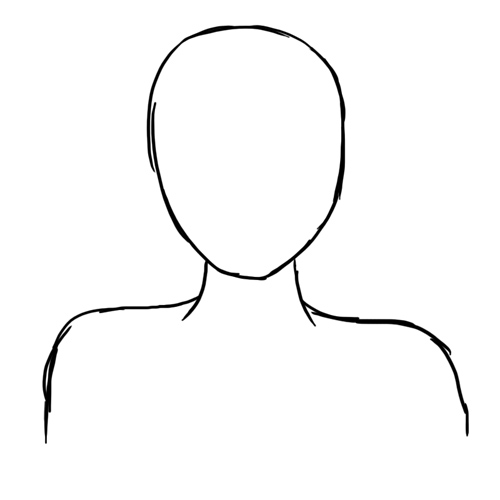
Step 2
Once you’re happy with your general layout, lower the Opacity of that layer to 30% so that you can still see your layout, but will also clearly see anything you add over the top. You’ll need to create a new layer now (Ctrl + Shift + N) for the main sketch. Name your new layer “sketch.” Using the Ellipse Shape Tool (U) set to Paths, create a circle roughly the same size as the top of the head on your layout sketch (see image below). Tip: If you hold down Shift while using the Ellipse Tool (U), you will create a perfect circle. Once you’re happy with your circle, stroke the path using a 3px standard brush, and make sure the pen pressure box is unchecked. Delete the path after this. Then, add a small line where the center of the character’s chin would be.
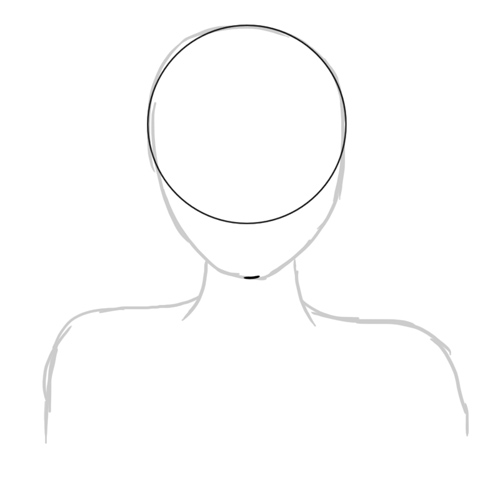
Step 3
Using the Pen Tool (P), start a new path from the center of your chin line up to where the edge of your circle touches the lower part of the head on your original layout. Do this both sides of the head so it looks like the example on the left of the image below. Then, by adding a point to the middle of each path and dragging them outwards, curve the paths a little to follow your layout. This creates the cheeks and lower part of your character’s head.

Step 4
You can now stroke the two paths you just made with the same 3px standard brush you used for the circle. The example is done in red to show the new lines, but you can continue yours in black. This basic method from the past few steps is a good foundation for creating a general anime-style shaped head, as the circle part will generally stay the same, and the cheek lines will change depending on the placement of the chin line. Further tutorials of mine will show you how to draw characters from various angles, but for now, we’ll focus on a basic front-facing bust like this one.
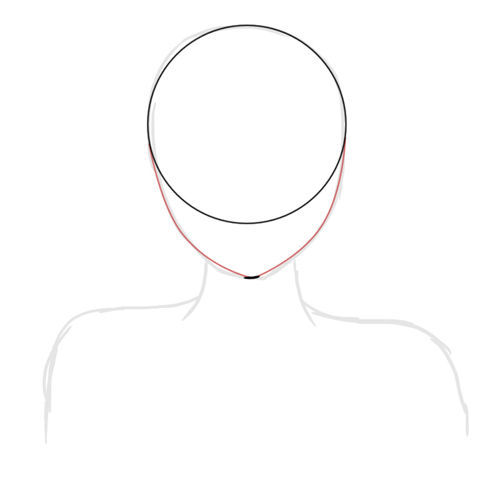
Step 5
Create a new layer (Ctrl + Shift + N) above your current layers and name it “guides.” This layer wont be part of the final drawing, but will help you with the placement of the facial features. Draw a red line from the very bottom of the main circle across the whole head shape. The center of the nose and the center of the mouth will be equidistant from this red line, which is what the blue lines on the example below represent. As you become familiar with drawing in the anime style, you may not need to always add these guides, and as your own sketch may be a different size to mine, I can’t give an exact distance to add the guidelines, so for now, add yours so they appear a similar distance from the red line as mine.

Step 6
Next, draw another blue line across where your cheek lines meet the circle (the top blue line on the example below). This is where the top of the character’s eyes will start. The final blue line will act as a guide for where the bottom of the eyes will be. Mine is the same distance above the nose line as the nose line is from the original red line. You can experiment with different sizes and styles of eyes, but for now, add yours in roughly the same place.
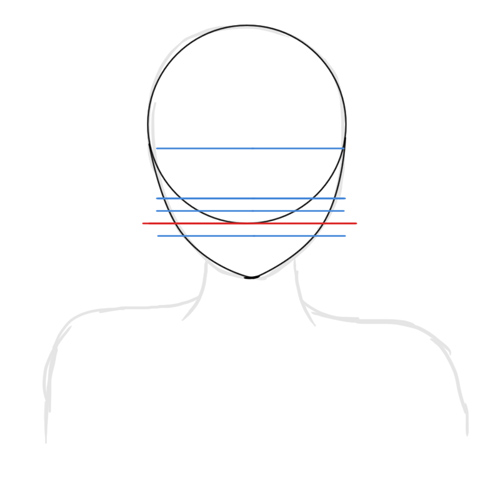
Step 7
Hide your “guides” layer. Erase the bottom half of the circle that would be inside the head shape, and neaten your chin line a little. You can also now add the rest of the main sketch to the “sketch” layer. Use the Pen Tool (P) to copy your layout and create clean and easy-to-follow lines like you did with the head shape, stroking the paths with a 3px standard brush. This is the stage to fix anything if it doesn’t seem right to you. Once you’re happy with it, you can hide your original layout layer, and you’ll be left with something similar to the example below.
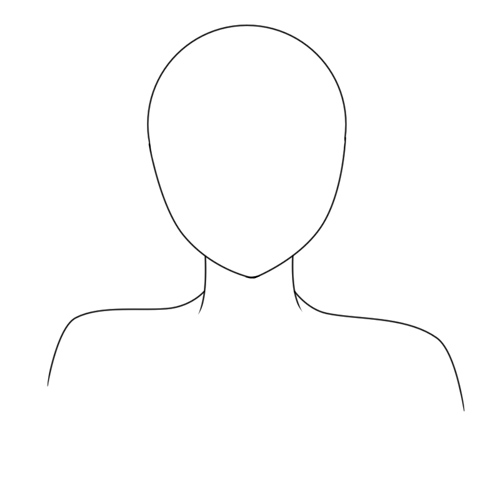
Step 8
The next thing we’ll be working on is the face. In an anime drawing, the eyes are often an important and defining factor of the image, so I’ve given a few examples of different styles of eye that you could try for your drawing. Female characters often have eyelashes of some sort, and male characters tend not to. I’m making mine a female character, but you can choose to create a male character if you prefer.
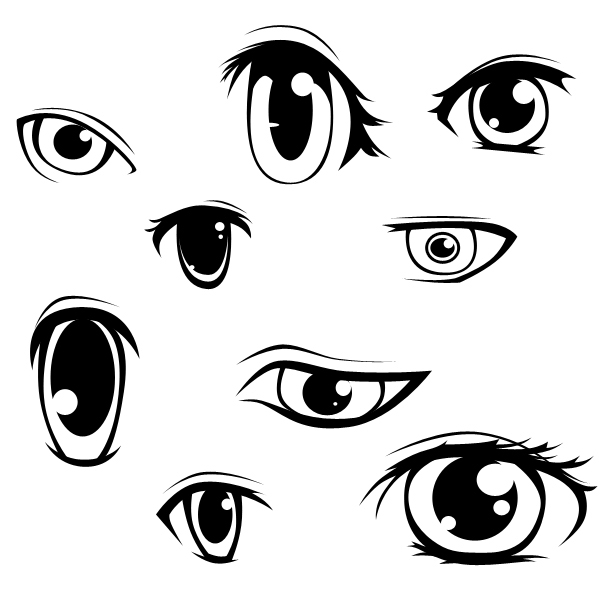
Step 9
Unhide your “guides” layer, get rid of the red line, and lower the Opacity of the layer. I’ve desaturated my “guides” layer as well, which you can do if you prefer. The eyes will be drawn between the two guide lines we added for them, and don’t forget to add a small line above for the eyelid, as shown on the examples above and below. Noses and mouths are often very simple in the anime style and can appear more like symbols to represent the features rather than being particularly detailed. The nose I have drawn is a simple triangle shape with a small dot next to it to represent a nostril. The mouth is a line, curving up at each end, with a small gap in the middle. I’ve also added a small line below the mouth line to suggest the bottom of the lip. Use your guidelines to help you with the placement, and hide or delete the “guides” layer once you’re happy with what you’ve drawn for the face.

Step 10
Now we’re going to work on giving the character some clothing. As the tutorial doesn’t specifically cover a male or female character, the clothing we’re going to add to the character will be fairly androgynous – a shirt, jacket and tie. Create a new layer (Ctrl + Shift + N) above your other layers and name it “clothes1.” When sketching over the top of another sketch as we will do now, I prefer to use red so it is easy to differentiate. As the images below explain, first we’ll add a V-shape round the neck that overlaps a little at the bottom. This is the inside of the jacket. Next, add the jacket breast by adding curved triangular shapes outside the original V-shape. I’ve given mine little triangle cut-outs for added interest. Don’t forget to add the clothing above the shoulders to give dimension so it doesn’t appear the clothing is simply painted onto the character. Add two triangles inside the jacket for the shirt, and then draw a tie shape beneath. Two curved lines either side of the jacket breast to show the character’s arms, and carry on the main sketch down to the bottom of the canvas (see example 5 below). Finally, add some lines at the shoulders to show seam-lines, and lines to show folds at the armpits and in the crook of the tie.
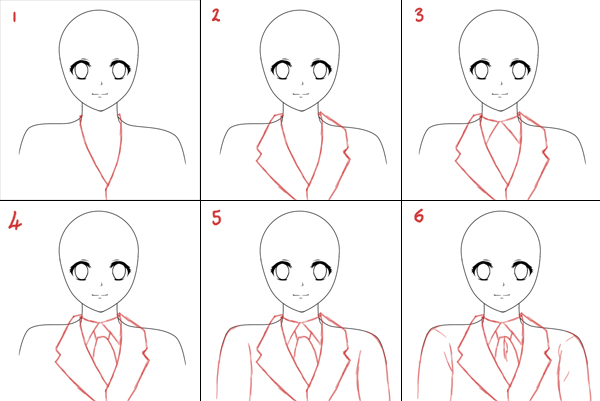
Step 11
I’ve also added a few extra bits of detailing to the jacket on my character, firstly to make it a little more interesting, but also to make it more feminine as I am drawing a female character. Once you’re happy with your jacket, you can make the sketch black.

Step 12
On another new layer (Ctrl + Shift + N), which you can call “hair1,” sketch out how you’d like the hair of your character to look. I have chosen a medium-length style with bangs, and ponytails to the side. This initial sketch doesn’t need to be particularly neat, as you can see. You’re really just getting an idea for the flow and shape of the hair here, and you’ll create a clean, neat sketch later.
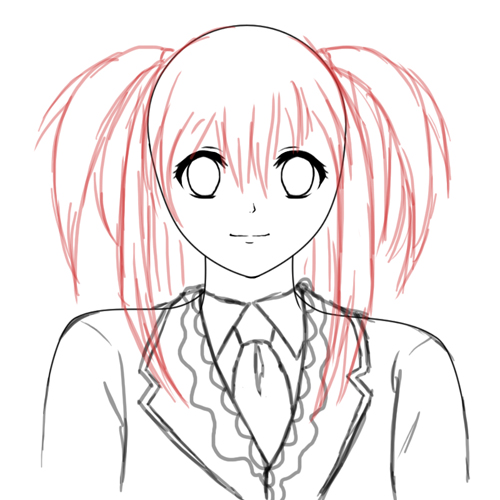
Step 13
Here’s some suggestions for other hair styles you could try for your character. If you’re drawing a male character, try the top right hair style, or make up your own. Once you’re happy with the hair you’ve sketched out, turn the sketch black.
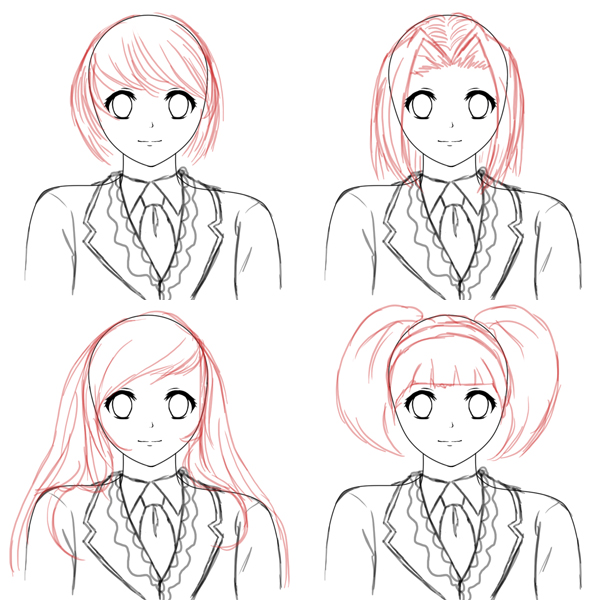
Step 14
Hide your “hair1” layer for a bit while we make the clothing sketches a bit neater and easier to follow. Create a new layer (Ctrl + Shift + N) and call it “clothes2”, while making your “clothes1” layer around 30% Opacity. On your new “clothes2” layer, and using the red color again, start making a nice clean sketch. I used the Pen Tool (P) and Stroke-Path method for this, again with a 3px standard brush.

Step 15
Once you’ve finished drawing your new clean sketch, you can hide the “clothes1” layer, leaving you with something similar to the example below. Now you’ll need to erase any overlapping lines that shouldn’t be there, such as the neck and shoulders on your “sketch” layer which would be hidden by the clothing. This is where doing your “clothes2” sketch in red and on a separate layer is quite useful, as it makes it much easier to see where you need to erase.
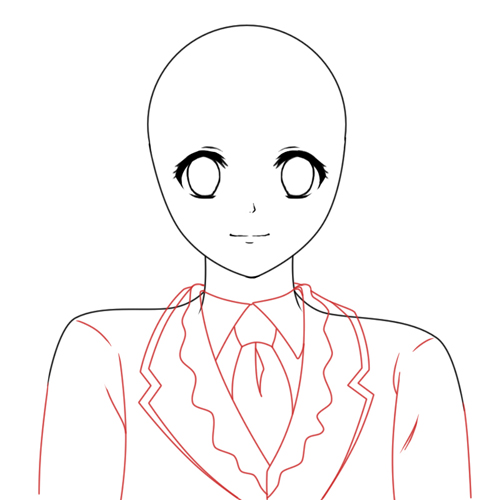
Step 16
Once you’ve erased any surplus lines and are happy with how it looks, make your “clothes2” sketch black, and merge it down as part of your “sketch” layer. You can delete your “clothes1” layer now. You should now have something similar to the drawing below, which means we’re ready to work on the hair.

Step 17
As you’ve done with previous layers, you’ll need to unhide your “hair1” layer and lower the Opacity to 30%. Create a new layer (Ctrl + Shift + N) above called “hair2” and, using the red and a 3px standard brush, create your clean sketch. Remember it’s still just a sketch, and we’re going to make the line art next, so you don’t need to worry if it looks a little messy at this stage. We’re just building a foundation that will be easy to work from when it comes to the vector rendering.
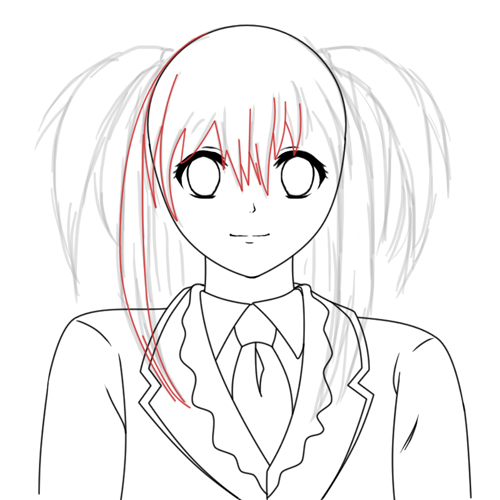
Step 18
Once you’ve finished making your new hair sketch, you can delete the “hair1” layer. Now you’ll need to erase any surplus lines from your “sketch” layer that would be covered by hair, like you did for the clothing. In this case, it will be the sides of the head and some of the clothing where the longer bangs are in front.
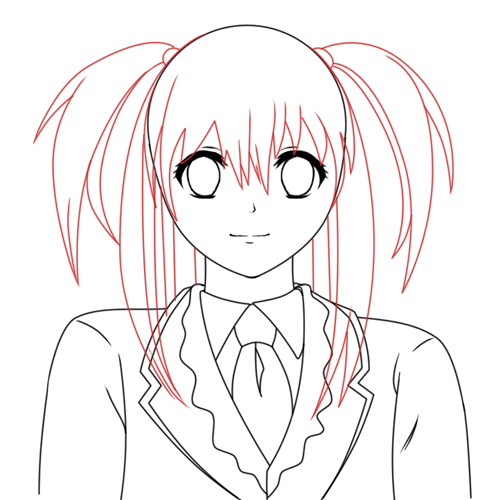
Step 19
Once you’ve erased the lines you need to, you can turn the “hair2” sketch black, and merge the layer down into the “sketch” layer. All your visible sketches should be on the same “sketch” layer now, and any hidden layers you have left, if any, can be deleted.
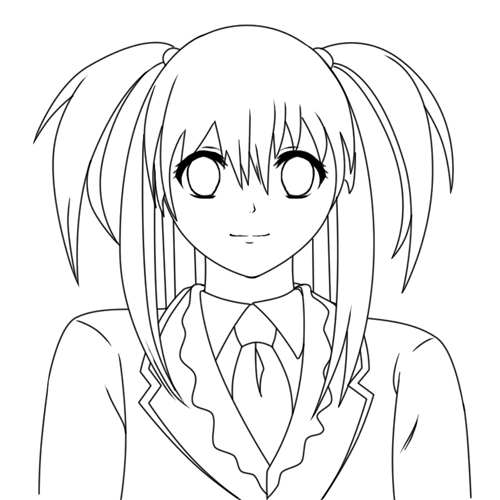
Step 20
This is the final stage of creating a clean sketch to follow, which is adding any details needed before we move on to line art, and then on to color in part two of this tutorial set. These final details include adding the pupils and highlights to the eyes, making sure your character has ears where they would be visible, adding eyebrows, bows to the hair, and any other final additions or changes you’d like to make to your sketch before you render it.

Step 21
Once you’re happy with your final sketch, you can make sure its all merged into one sketch layer, and then make that layer 30% Opacity. Now you’ll need to create a folder above your sketch and white background layer for your vector work, to help organize your layers. To do this, click the folder-shaped icon at the bottom of the layers tab, which should say “Create a new group” on hover. Name this folder “vector.” You’ll need to make sure, next, that your Pen Tool (P) options are set to create vector shapes as we no longer need the Paths option we used for the sketches. Check your options with those shown in the image below.
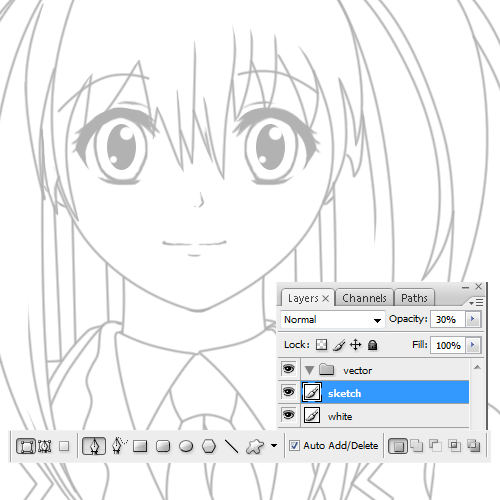
Step 22
Using the Pen Tool (P), begin tracing your sketch. I like to start with the face as it builds a good foundation for the general look of your character, I feel. Don’t add line art for the pupils or highlights in the eyes – we’ll do those when it comes to the coloring stage in the next tutorial.
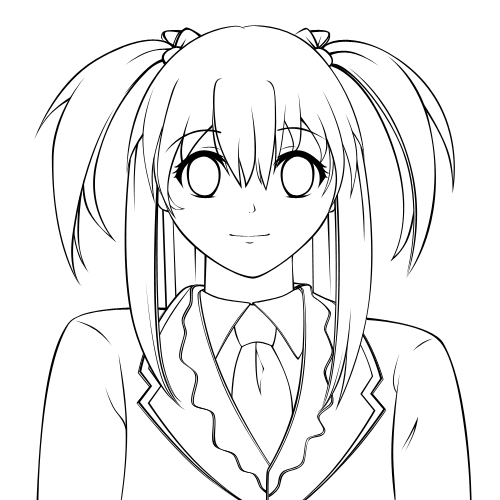
Step 23
As you’re working, lower the opacity of your sketch layer every now and then to see how your line work is coming along.

Step 24
The line art stage is the time to add the little details. In this case, I have added secondary lines round the edges of the jacket here, because remember that clothes are not flat – they are three dimensional objects, and will have visible edges!

Step 25
Keep working on your lines, and take your time to make sure they look right. I have changed the position of the indent on the right hand side of the jacket so it looks more even. Don’t be afraid to deviate from your sketch if you need to. Remember the edges, and keep adding the detail and depth to the drawing.

Step 26
Once you’ve finished the lines for the face and jacket, you may wish to create a folder for them inside your vector folder and name it “other lines” for example, and move these line art shape layers into the new folder. I generally like to keep the hair lines and the other lines separate and will create a new folder for the hair lines only now, called “hair lines.” This is completely up to you – I just prefer to keep my layers organized in this way.

Step 27
When you move on to the hair lines, start with the top of the head and the bangs as you will find the rest of the hair easier once you have these down. I’ve added a parting at the top of the head, as you can see below, which is another way to add that little extra bit of detail to your anime character.

Step 28
I’ve deviated from my sketch a little on the bangs to give a better shape. I’ve also added detail by overlapping strands on the left hand side, over her cheek, and by using varied line widths. Continue with this method of creating the line art for the hair, and don’t worry about the overlapping lines further down where the hair comes down over the clothing – we’ll sort that in the next step.
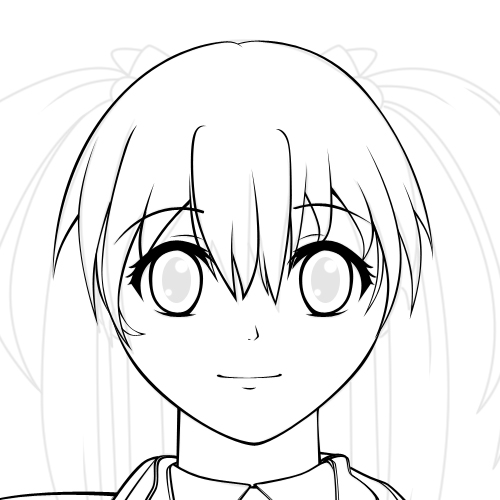
Step 29
Where your lines overlap, such as the hair in front of the shoulder here, rather than stopping and starting your lines, you can use the Subtract from shape area tool (-), which is the middle icon, highlighted in blue in the example tool bar below. You will find this on your regular Pen Tool (P) options along the top of your regular program page.

Step 30
With the Subtract from shape area icon, shown above, clicked, draw a small box around the area of line you wish to remove, and it will be erased from view. Do this to all the areas you need to remove overlapping lines. This method is not only easier than trying to create ‘stop-start’ line art around overlapping features such as hair, but also gives a much smoother finish.

Step 31
Once you’re done with the hair, go back to your other lines folder – if you made one – and add the bows and ears to your character, remembering that bows will have creases in the middle where the fabric folds. Once you’re happy with the lines you’ve created, create a folder named “lines” within the “vector” folder, and add either all your shape layers, or your folders, depending on how you’ve organized them, to this new folder. You can hide the “sketch” layer now.
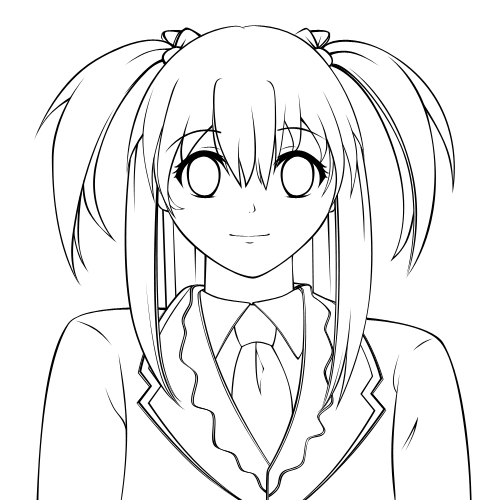
Conclusion
Congratulations! You have now created a basic anime styled portrait line art, ready to color in part two. I’d love to see the characters you’ve created, and I hope you enjoyed this tutorial. See you in part two this Friday, when we’ll be bringing these characters to life!

